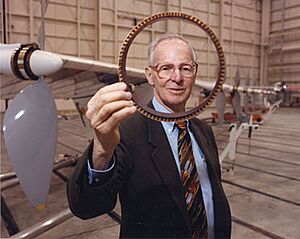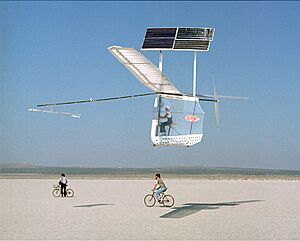Paul MacCready facts for kids
Quick facts for kids
Paul MacCready
|
|
|---|---|

MacCready shows a cross section of the Helios Prototype wing spar.
|
|
| Born |
Paul Beattie MacCready Jr.
September 25, 1925 New Haven, Connecticut, U.S.
|
| Died | August 28, 2007 (aged 81) Pasadena, California, U.S.
|
| Education |
|
| Occupation | Engineer |
| Engineering career | |
| Projects | AeroVironment |
Paul B. MacCready Jr. (born September 25, 1925 – died August 28, 2007) was an amazing American aeronautical engineer. He was known for creating human-powered aircraft and other super-efficient vehicles. Paul MacCready founded a company called AeroVironment. He spent his life trying to "do more with less," meaning he wanted to create things that worked well using fewer resources.
Contents
Early Life and Learning
Paul MacCready was born in New Haven, Connecticut. Even as a young boy, he loved inventing things. When he was just 15, he won a national contest for building a model flying machine!
He once said that he was "always the smallest kid" and not very athletic. Because of this, he found a lot of joy and confidence in building model airplanes and creating new things.
Paul went to Hopkins School and graduated in 1943. He then trained to be a US Navy pilot during World War II. After the war, he continued his education. He earned a bachelor's degree in physics from Yale University in 1947. Then, he got a master's degree in physics from Caltech in 1948. Finally, he earned his PhD in aeronautics from Caltech in 1952.
In 1951, Paul started his first company, Meteorology Research Inc. This company focused on studying the atmosphere. He was also one of the first people to use airplanes to study weather.
Amazing Inventions and Achievements
Paul MacCready loved gliding after World War II. He was a champion glider pilot, winning the U.S. National Open Class Soaring Champion award three times (1948, 1949, 1953). In 1956, he became the first American to win the World Soaring Champion title.
He invented a special device for glider pilots. This device helps them know the best speed to fly their glider based on weather conditions. Glider pilots still use his "MacCready speed ring" today!
Winning the Kremer Prize
In the 1970s, Paul found himself in debt. This motivated him to compete for the £50,000 Kremer prize. This prize was for the first successful human-powered aircraft flight. The prize had been available for 18 years, but no one had won it yet.
Working with Dr. Peter B.S. Lissaman, Paul designed a human-powered plane called the Gossamer Condor. This amazing plane was made from simple materials like aluminum tubing, plastic foam, piano wire, bicycle parts, and Mylar foil. In August 1977, the Condor flew for seven minutes and completed the required figure-eight course. Paul MacCready and his team won the first Kremer prize!
Crossing the English Channel
After this success, the Kremer prize offered another £100,000. This new prize was for the first human-powered flight across the English Channel. Paul MacCready accepted the challenge.
In 1979, he built a new plane, the Gossamer Albatross, which was even better than the Condor. The Albatross successfully flew from England to France! This incredible flight won him the second Kremer prize. He also received the Collier Trophy, a very important award for achievements in aviation.
Solar-Powered Aircraft and Electric Cars
Paul MacCready didn't stop there. He went on to create solar-powered aircraft. These included the Gossamer Penguin and the Solar Challenger. He also helped NASA develop solar-powered flying wings like the Helios. The Helios broke altitude records and could even fly in the thin atmosphere of Mars!
He also worked with General Motors on the Sunraycer, a solar-powered car. Later, he helped design the EV-1 electric car.
Flying Dinosaurs
In 1985, the Smithsonian Institution asked Paul to build something truly unique. They wanted a half-scale flying replica of a pterosaur called Quetzalcoatlus. This ancient flying reptile had a wingspan of 18 feet!
Paul's team built a remote-controlled model that could fly. It was filmed over Death Valley, California, for an IMAX movie called On the Wing. The model flew successfully several times. However, it crashed during an airshow due to a radio signal problem.
Paul MacCready also helped create the Nissan Dempsey/MacCready Prize. This prize encouraged new ideas in racing bicycle technology, making human-powered vehicles faster.
He founded AeroVironment Inc. in 1971. This company develops unmanned aircraft for surveillance and advanced power systems. AeroVironment even flew a prototype of the first airplane powered by hydrogen fuel cells!
Paul MacCready passed away on August 28, 2007, after an illness. He was survived by his wife, Judy, his three sons, and two grandchildren.
Awards and Honors
Paul MacCready received many awards for his incredible work:
- Inducted into the U.S. Soaring Hall of Fame, 1954
- Otto Lilienthal Medal, 1956 (for winning the World Soaring Champion title)
- Collier Trophy, 1979
- Reed Aeronautical Award, 1979 (for notable achievement in aeronautical science)
- Edward Longstreth Medal, 1979
- Engineer of the Century Gold Medal, 1980
- Spirit of St. Louis Medal, 1980
- Inventor of the Year Award, 1981
- Lindbergh Award, 1982 (for balancing technology and the environment)
- Golden Plate Award, 1982
- Guggenheim Medal, 1987
- National Air and Space Museum Trophy, 1988
- Enshrined in The National Aviation Hall of Fame, 1991
- Included in Time magazine's "The Century's Greatest Minds" in 1999
- Howard Hughes Memorial Award, 1999
- National Design Award – Product Design, 2000
- Hoyt Clarke Hottel Award, 2001 (for inventing the first solar-powered aircraft)
- The 9th Annual Heinz Award in Technology, the Economy and Employment, 2003
- Bower Award and Prize for Achievement in Science, 2003
- Inducted into National Inventors Hall of Fame, 2015
Other Interests and Ideas
Paul MacCready was very passionate about the environment. He was concerned about how humans use natural resources. He believed in using reason and intelligence to solve problems and make the world a better place.
He often lectured about creativity and his ideas. He loved sharing his message with everyone, including children. He wanted to inspire others to think creatively and care for our planet.
Paul gave talks at TED conferences. In 1998, he spoke about nature versus humans and his idea of "doing more with less." In 2003, he gave another TED talk called "A Flight on Solar Wings."
Famous Quotes
Paul MacCready had many wise things to say:
Over billions of years on a unique sphere, chance has painted a thin covering of life -- complex, improbable, wonderful and fragile. Suddenly, we humans, (a recently arrived species, no longer subject to the checks and balances inherent in nature), have grown in population, technology and intelligence to a position of terrible power: we now wield the paintbrush.
Anyone who's not interested in model airplanes must have a screw loose somewhere
I'm more interested in a world that works than what sells


